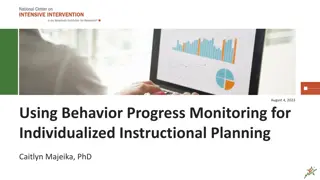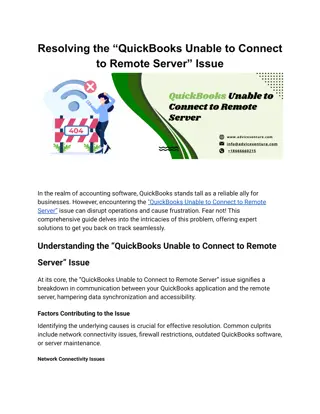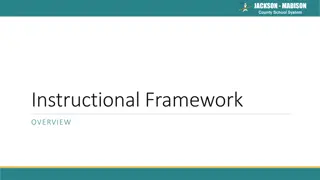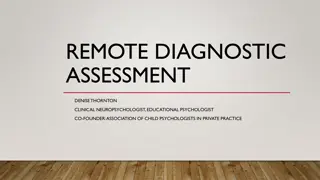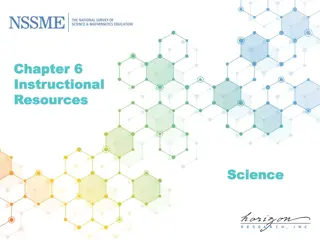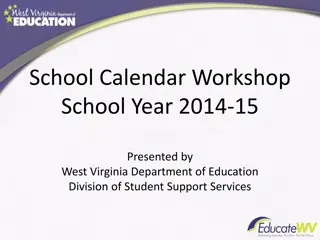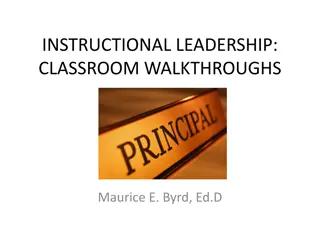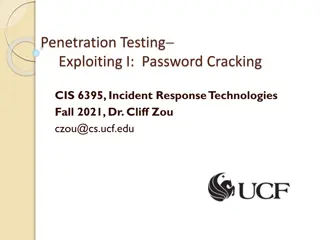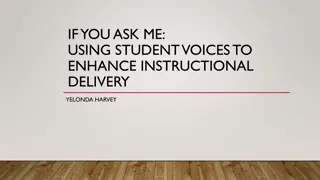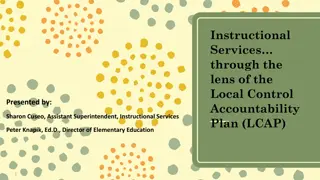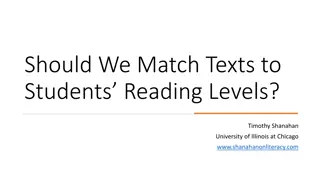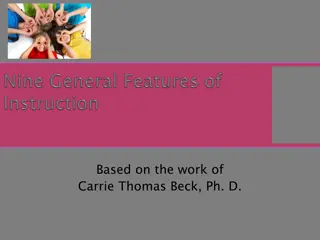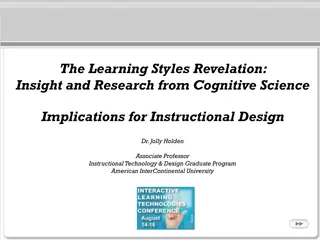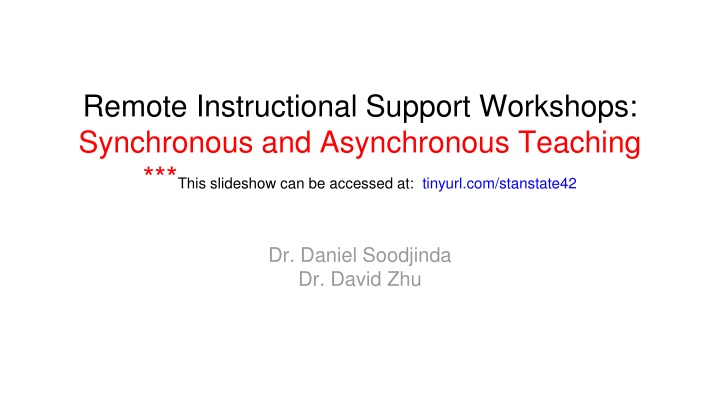
Effective Strategies for Synchronous and Asynchronous Teaching
Explore the differences between synchronous and asynchronous teaching methods, their advantages and challenges, and how to blend them for an optimal learning experience. Discover tips for creating engaging online courses tailored to diverse student needs.
Download Presentation

Please find below an Image/Link to download the presentation.
The content on the website is provided AS IS for your information and personal use only. It may not be sold, licensed, or shared on other websites without obtaining consent from the author. If you encounter any issues during the download, it is possible that the publisher has removed the file from their server.
You are allowed to download the files provided on this website for personal or commercial use, subject to the condition that they are used lawfully. All files are the property of their respective owners.
The content on the website is provided AS IS for your information and personal use only. It may not be sold, licensed, or shared on other websites without obtaining consent from the author.
E N D
Presentation Transcript
Remote Instructional Support Workshops: Synchronous and Asynchronous Teaching ***This slideshow can be accessed at: tinyurl.com/stanstate42 Dr. Daniel Soodjinda Dr. David Zhu
Welcome! Meeting norms Microphones muted Cameras on or off Raise/lower hand (virtually) Chat Meeting is recorded Please introduce yourself Name Department / Subject area How comfortable are you with teaching an online course?
Agenda Welcome and introductions Definitions / shared vocabulary Pros and cons of synchronous instruction Pros and cons of asynchronous instruction Questions to consider Sample of synchronous instructional practices Sample of asynchronous instructional practices Developing a hybrid of synchronous and asynchronous instructional approaches
Definitions Synchronous Instruction Class meetings are live and in real-time Designated date/time of class meetings Learning activities can occur in real-time or before/after meetings Can be teacher-centered or learner-centered Asynchronous Instruction No scheduled live class meetings Students interact with the course based on their own schedule Learning activities can occur at anytime Lends itself to more learner-centered instruction
Synchronous Instruction R Develops community In the moment (formative) assessments Allows for collaborative learning activities Immediate feedback to student questions Can be similar to a face-to-face courses (we kind of already know how to do it) Instructor presence is natural Easier to plan Sessions can be recorded and viewed later (allows for some flexibility) Instructor controls pace of instruction Rigid schedules can impact student engagement Learners can be left behind Quality of sessions depends on instructor Requires a learning space in students homes Requires high speed internet, better hardware Can be more challenging for students with special needs
Asynchronous Instruction R Students control pace of instruction Allows for flexibility in students lives Students can participate at anytime in any place Can be more accessible for students Does not require access to stable high speed internet or specific hardware Student contact is limited to email, phone, LMS Learners may feel isolated Requires student self-discipline Limited opportunities for formative assessment Requires more work to plan engaging lessons Instructor presence is manufactured
Questions to consider Does the course/subject area lend itself better to one type of method? Do you want students to interact with each other? How comfortable are you with planning an online class? How much time do you want to spend planning your class and each lesson? How much time do you want to spend assessing student work? Do you have students with special needs? Should you utilize both methods?
Sample of Synchronous Instructional Practices
Getting started and setting the tone Spend the first couple meetings to create a set of meeting norms (practice meetings) Review the recommended Zoom settings for synchronous meetings Become familiar with tools (waiting room, kicking people out, sharing your screen including IPADs/tablets via airplay or doc cameras, polls, recording options, virtual backgrounds) Show students how you d like them to utilize the meeting s tools (zoom) Norms for participation, video cameras, microphone settings, chat (public/private), renaming Instructor s video camera on? - I think it might help Use the live setting to create a sense of community Allow for student check-ins Create ice-breakers Review previous content - answer questions, and make connections to new content Provide an overview of what is coming Preview the session s agenda Expectations for assignments and future tasks/projects
Teacher-centered approaches in synchronous meetings Directed teaching = Lecturing Consider a balance of directed instruction (lecture) and informal assessments to engage students (leverage the technology that is there) When posing questions - give students time to respond (ex: Before you raise your hand, I want to give everyone one minute to think through this question. ) You can also consider discussion question sign-ups Accompany lectures with interactive visuals (powerpoint, slideshow) and give students access to it (before the lecture begins) Keep traditional lectures to a minimum - OR - record a lectures and ask that they be viewed before live sessions Allows the live sessions to focus on collaborative learning experiences Consider recording the live meeting so that students don t feel pressured to frantically take notes
Student-centered approaches in synchronous meetings Active involvement that calls for student presence Cooperative (small group) group activities Group norms (recommendation to have cameras on?) Breakout rooms (understand zoom limitations with group assignments and recording) OR - consider student created zoom rooms for cooperative group work (can be recorded) Set clear goals and expectations for group work Hold groups accountable for student engagement/participation breakout room check-in instructor created shared doc (for assessment purposes) communicate with groups regularly via chat or broadcast Give students plenty of time to complete group tasks Dynamic group share out Informal assessments via forms/surveys and polling, chat comments/gestures, external tools (nearpod, google forms, additional resources)
Breakout room activity Group norms While in breakout rooms, please consider turning on your camera s (if you are able to) Microphones can be unmuted if in a quiet space, or you can leave muted until you want to speak Group expectations Have a discussion about the following questions: What challenges/issues did you face when transitioning your course from in-person to online? Are there any good practices that you can recommend? Take notes and create talking points on this shared slideshow and your group s breakout room slide Group share out and debrief
Sample of Asynchronous Instructional Practices
Strategies in Asynchronous Instruction Asynchronous teaching is challenging as it is not a traditional method. While the benefits of flexibility is very attractive to students, students are also required to overcome many cons that we have listed in previous slide. The major considerations that an instructor need to focus on are: - - - Communication Engagement Evaluation
Communication - Course organization: the nature of asynchronous teaching is the lack of instant feedback from the instructors. It is crucial that the students have a very clear and holistic view of the course: learning objectives, expected learning pace, expected learning outcome, etc. Method of teaching: how are the course materials to be delivered? Video recording, audio recording, PowerPoint slides, whiteboard, surveys, etc. Tools: - Blackboard, Canvas, Moodle - Zoom, Microsoft Team - VoiceThread - -
Engagement and Evaluations Student engagement is sometimes puzzling for asynchronous instructions. Student self-discipline and motivation is always required, and need to be enforced. - - - - - - Announcements and emails, text messages if necessary FAQ Assignments Quizzes Exams Discussion Board (graded or not graded)
Combing both synchronous and asynchronous methods Some professors may find the combination of these two methods beneficial. - - Take the advantages of both methods. Controls by the instructor about how much to be synchronous or asynchronous. Student self-discipline and motivation is still required. Some considerations: - Need to make the course listed as synchronous for registration - Need to be considerate about the students readiness for synchronous online learning: equipment (computer, camera, microphone), network speed, family issues, etc. - -
Debrief, Questions and Thank You! Daniel Soodjinda, Ed.D. Associate Professor of Liberal Studies and Teacher Education dsoodjinda@csustan.edu 202.230.7063 mobile David Zhu, Ph.D. Associate Professor of Accounting dzhu@csustan.edu 330.289.9213 mobile



